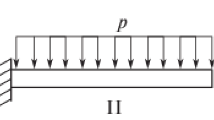It is shown that it is possible to create branchy and shaped composite leaf springs with a constant cross-sectional area and three-fold reduced weight, at a given level of accumulated elastic energy, by choosing an appropriate spring geometry. The advantages of branching in comparison with shaping are the absence of cut fibers, exclusion of fiber disorientation, and the possibility of decreasing the spring size by combining its leafs into a bundle. The use of a unidirectional GFRP makes it possible to multiply reduce the spring weight compared with that of a steel analog with the same strength and stored energy requirements. An efficient use of branchy composite springs is possible for transport systems and, in the future, for space-based constructions due to their low weight and the extremely low energy of their production, and these factors allow one, in principle, to create such springs directly in orbit conditions.






Similar content being viewed by others
References
A. N. Polilov, N. A. Tatus’, and V. V. Shabalin, “Features of the design of elastic elements in the form of shaped composite beams,” Probl. Mashinostr. Nadezhn. Mash., No. 6, 34-41 (2011).
A. N. Polilov, I. S. Plitov, and N. A. Tatus’, “Computer modellng of a rational structure of the curvilinear reinforcement of shaped composite elements,” Probl. Mashinostr. Automat., No. 4, 74-79 (2013).
A. N. Polilov, N. A. Tatus’; and I. S. Plitov, “Estimation of the influence of fiber disorientation on the stiffness and strength of shaped composite elements,” Probl. Mashinostr. Nadezhn. Mash., No. 5, 58-67 (2013)
K. Schulgasser and A. Witztum, “On the strength of herbaceous vascular plant stems,” Annals of Botany. 80, 35-44 (1997).
C. Eloy, “Leonardo’s rule, self-similarity and wind-induced stresses in trees,” arXiv: 1105.2591v2 [physics. Bio-ph]. 15 Nov. 2011.
R. Minamino and M. Tateno, “Tree branching: Leonardo da Vinci’s rule versus biomechanical models,” Open Access available online. Plos one/www. Plosone. Org, April 2014. 9, Iss. 4, e 9535.
A. N. Polilov and N. A. Tatus’, “Design of branching or shaped composite elements by analogy with the structure of tree crown,” Probl. Mashinostr. Nadezhn. Mash., No. 4, 76-84 (2017).
A. N. Polilov and N. A. Tatus’; “Design of equistrong profiled, branched, or stratified elastic composite elements,” Izv. Vuz. Mashinostroenie, No. 5, 3-12 (2018).
A. N. Polilov, Etudes on the Mechanics of Composites [in Russian], M., Fizmatlit (2015).
A. N. Polilov and N. A. Tatus’, Biomechanics of the Strength of Fibrous Composites [in Russian], M., Fizmatlit (2018).
Author information
Authors and Affiliations
Corresponding author
Additional information
Translated from Mekhanika Kompozitnykh Materialov, Vol. 55, No. 3, pp. 465-482, May-June, 2019.
Rights and permissions
About this article
Cite this article
Polilov, A.N., Tatus, N.A., Tian, X. et al. Equistrong Branchy Composite Beams with a Constant Total Area of Variable Elliptic Cross Sections. Mech Compos Mater 55, 325–336 (2019). https://doi.org/10.1007/s11029-019-09815-y
Received:
Published:
Issue Date:
DOI: https://doi.org/10.1007/s11029-019-09815-y



